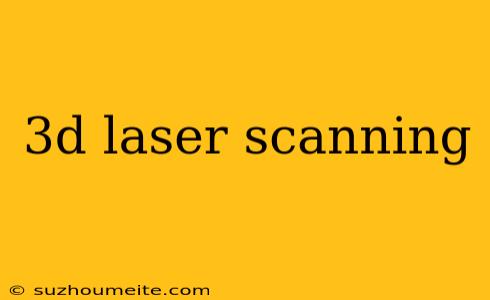3D Laser Scanning: Revolutionizing Data Capture and Analysis
Introduction
3D laser scanning is a cutting-edge technology that has revolutionized the way we capture and analyze data. This non-invasive, non-contact method uses laser light to create high-accuracy 3D models of objects, structures, and environments. In this article, we will delve into the world of 3D laser scanning, exploring its principles, applications, and benefits.
How 3D Laser Scanning Works
3D laser scanning works by emitting a low-intensity laser beam onto an object or surface. The laser beam is swept across the object, and the time-of-flight of the beam is measured as it bounces back to the scanner. This information is then used to create a 3D point cloud, which is a set of 3D coordinates that define the shape of the object.
Advantages of 3D Laser Scanning
High Accuracy
3D laser scanning provides highly accurate measurements, with some scanners offering accuracy down to 1 mm.
Non-Invasive
Laser scanning is a non-invasive technique, making it ideal for capturing data from delicate or fragile objects.
Fast Data Capture
Laser scanning can capture data at extremely high speeds, making it ideal for large-scale projects.
** Versatility**
Laser scanning can be used in a wide range of applications, from architecture to forensics.
Applications of 3D Laser Scanning
Architecture and Engineering
Laser scanning is used to capture existing building conditions, document as-built structures, and monitor construction progress.
Surveying and Mapping
Laser scanning is used to create detailed topographic maps, monitor land deformation, and track changes in environmental conditions.
Forensic Science
Laser scanning is used to document crime scenes, analyze accident scenes, and recreate events.
Heritage Preservation
Laser scanning is used to document and preserve cultural heritage sites, monuments, and artifacts.
Benefits of 3D Laser Scanning
Improved Accuracy
Laser scanning provides accurate data, reducing errors and improving decision-making.
Increased Efficiency
Laser scanning reduces the time and cost associated with traditional data capture methods.
Enhanced Collaboration
Laser scanning enables stakeholders to share accurate data, improving collaboration and communication.
Better Decision-Making
Laser scanning provides detailed insights, enabling informed decision-making and improved outcomes.
Conclusion
3D laser scanning is a powerful tool that has transformed the way we capture and analyze data. With its high accuracy, versatility, and speed, laser scanning has become an essential tool in various industries. As technology continues to evolve, we can expect to see even more innovative applications of 3D laser scanning.
